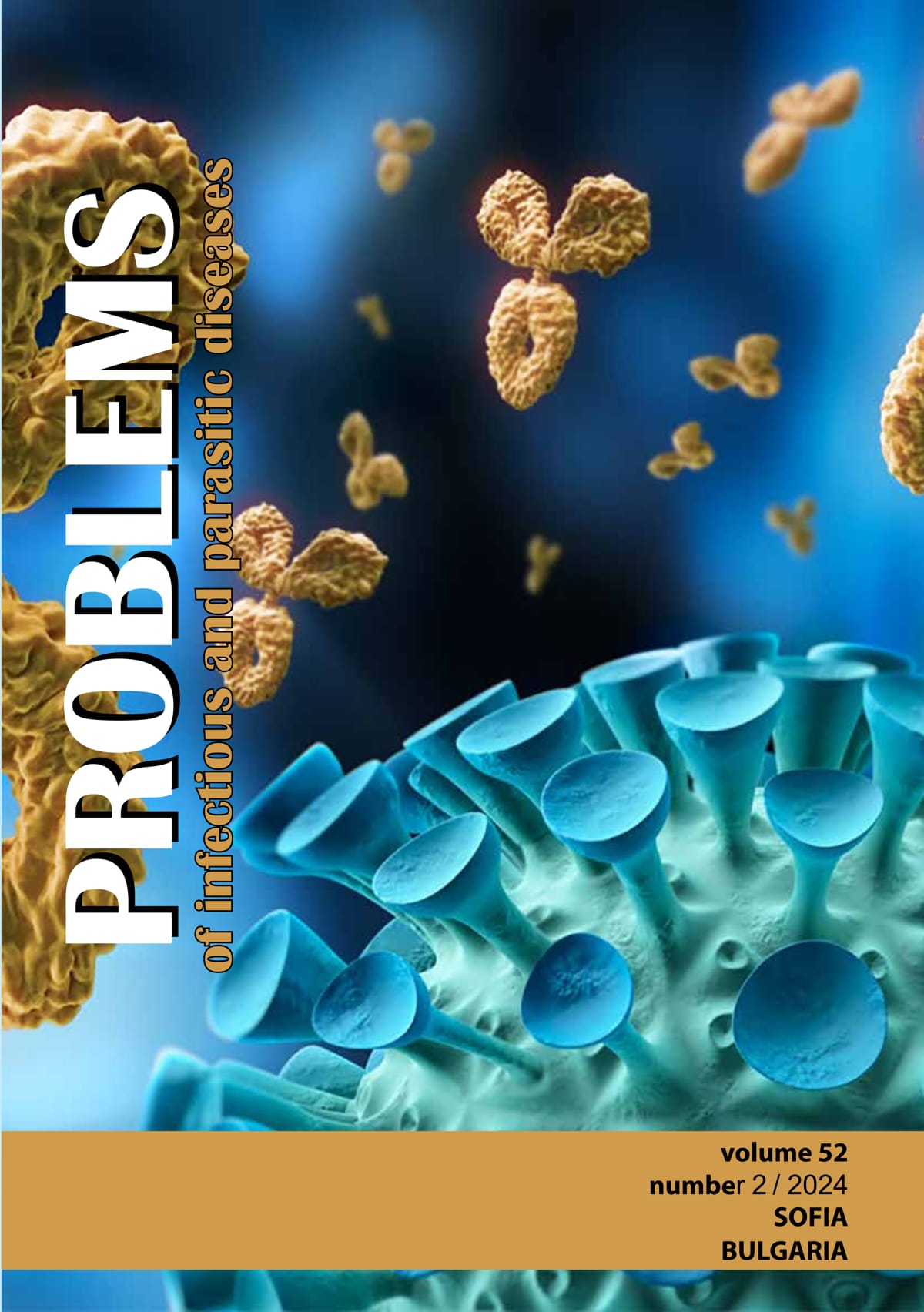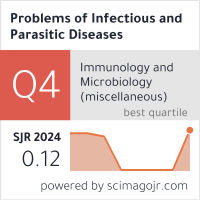HUMAN PATHOGENS AMONG BATS
DOI:
https://doi.org/10.58395/51hccc30Keywords:
bats, virome, bacteriome, metagenomics, zoonoses, vector, ectoparasitesAbstract
Bats are known to inhabit both caves and open space areas. Bulgaria is among the Еuropean countries with the highest number of bat species. The species found in the country are distributed over a wide area. They range from the Pyrenees and the British Isles to the Pacific region and the Far East. Many bat species are carriers of potential human pathogens. Bats play an important role in agriculture and act as a biological pest crop control agent. Bulgarian bat ecosystem comprises temperate climate and a wide range of abiotic factors, including humidity, darkness, sunlight, and temperature variations. The metabolism of bats and their body temperature vary significantly between the period of activity and the hibernation. Fluctuations in body temperature can potentially impact host microbiome biodiversity. Temperature variations may induce a high level of microbial mutagenesis. Additionally,the existence in large, mixed-species colonies, togeteher with a relatively long individual lifespan (4 – 16 years) and extensive travel distances, enhances the likelihood of encountering multiple pathogens in a single host organism. This, in turn, facilitates genetic variations and re-combinations among those microbial pathogens, thereby raising their potential to breach species barriers. In this review, we summarized and analyzed the available scientific information concerning the potential microbial human pathogens associated with bats, alongside with our preliminary data on the biodiversity of bats blood microbiome. Future research should focus on bats as both pathogens carriers and dynamic models for predicting emerging and re-emerging zoonotic diseases.
Downloads
References
1. Petrov B. Bats - Methodology for environmental impact assessment and appropriate assessment. A manual for developers, environmental experts, and planning authorities. (in Bulgarian) National Museum of Natural History-BAS 2008. 76-79.
2. Culina A, Garroway CJ. Bats use social information within and across species. J Anim Ecol. 2019; 88(10):1444-1446. https://doi.org/10.1111/1365-2656.13093
3. Webb, P. I., Speakman, J. R., Racey, P. A. How hot is a hibernaculum? A review of the temperatures at which bats hibernate. Can J Zool. 1996; 74(4): 761-765. https://doi.org/10.1139/z96-087
4. Mundinger, C., Fleischer, T., Scheuerlein, A., Kerth G. Global warming leads to larger bats with a faster life history pace in the long-lived Bechstein's bat (Myotis bechsteinii). Commun Biol. 2022; 5(1):682. https://doi.org/10.1038/s42003-022-03611-6
5. Arlettaz, R., Christe P., and Desfay, M. 33 years, a new longevity record for a European bat. Mammalia. 2002; 66(3):441-442.
6. Banerjee A., Baker ML., Kulcsar K., Misra V., Plowright R., Mossman K. Novel insights into immune systems of bats. Front Immunol. 2020; 11:26. https://doi.org/10.3389/fimmu.2020.00026
7. Dundarova H., Ivanova-Aleksandrova N., Bednarikova S., Georgieva I., Kirov K., Miteva K., Neov B., Ostoich P., Pikula J., Zukal J., Hristov P. Phylogeographic aspects of bat lyssaviruses in Europe: a review. Pathogens. 2023; 12(9): 1089. https://doi.org/10.3390/pathogens12091089
8. Kohl C., Nitsche A., Kurth A. Update on potentially zoonotic viruses of European bats. Vaccines (Basel). 2021; 9(7):690. https://doi.org/10.3390/vaccines9070690
9. Chen L., Liu B., Yang J., Jin Q. DBatVir: The database of bat- associated viruses. Database. 2014; 2014: bau021. https://doi.org/10.1093/database/bau021
10. Dwyer D. E. The origins of severe acute respiratory syndrome-Coronavirus-2. Semin Respir Crit Care Med. 2023; 44(1): 3-7. https://doi.org/10.1055/s-0042-1759564
11. Carneiro R. L., Farias J.P., Pinheiro J.R, Farias J., Vielmo A. C., Birbrair A., Belmok A., Melo F. L., Ribeiro B. M., Chaves G., Vidal P. O., Luiz W. B., Amorim J. H. First description of a multisystemic and lethal SARS-CoV-2 variant of concernP.1 (Gamma) Infection in a FeLV-positive Cat. Virol J. 2022; 19(1):93. https://doi.org/10.1186/s12985-022-01816-z
12. Temmam, S., Vongphayloth K., Baquero E. Munier S., Bonomi M., Regnault B., Douangboubpha B., Karami Y., Chrétien D., Sanamxay D., Xayaphet V., Paphaphanh P., Lacoste V., Somlor S., Lakeomany K., Phommavanh N., Pérot P., Dehan O., Amara F., Donati F., Bigot T., Nilges M., Rey F., van der Werf S., Brey P., Eloit M. Bat coronaviruses related to SARS-CoV-2 and infectious for human cells. Nature. 2022; 604: 330-336. https://doi.org/10.1038/s41586-022-04532-4
13. Diakoudi G., Lanave G., Moreno A., Chiapponi C., Sozzi E., Prosperi A., Larocca V., Losurdo M., Decaro N., Martella V., Lavazza A., Lelli D. Surveillance for Adenoviruses in bats in Italy. Viruses. 2019; 11(6):523. https://doi.org/10.3390/v11060523
14. Olival K. J., Hayman D. T. Filoviruses in bats: current knowledge and future directions. Viruses. 2014; 6(4):1759-88. https://doi.org/10.3390/v6041759
15. Simmonds P., Becher P., Bukh J., Gould E. A., Meyers G., Monath T., Muerhoff S., Pletnev A., Rico-Hesse R., Smith D. B., Stapleton J. T. Ictv Report Consortium. ICTV Virus taxonomy profile: Flaviviridae. J Gen Virol. 2017; 98(1):2-3. https://doi.org/10.1099/jgv.0.000672
16. Drexler J. F., Gloza-Rausch F., Glende J., Corman V. M., Muth D., Goettsche M., Seebens A., Niedrig M., Pfefferle S., Yordanov S., Zhelyazkov L., Hermanns U., Vallo P., Lukashev A., Müller M. A., Deng H., Herrler G., Drosten C. Genomic characterization of severe acute respiratory syndrome-related coronavirus in European bats and classification of coronaviruses based on partial RNA-dependent RNA polymerase gene sequences. J Virol. 2010; 84(21):11336-49. https://doi.org/10.1128/JVI.00650-10
17. Drexler J. F., Corman V. M., Müller M. A., Maganga G. D., Vallo P., Binger T., Gloza-Rausch F., Cottontail V. M., Rasche A., Yordanov S., Seebens A., Knörnschild M., Oppong S., Adu Sarkodie Y., Pongombo C., Lukashev A. N., Schmidt-Chanasit J., Stöcker A., Carneiro A. J., Erbar S., Maisner A., Fronhoffs F., Buettner R., Kalko E. K., Kruppa T., Franke C. R., Kallies R., Yandoko E. R., Herrler G., Reusken C., Hassanin A., Krüger D. H., Matthee S., Ulrich R. G., Leroy E. M., Drosten C. Bats host major mammalian paramyxoviruses. Nat Commun. 2012; (3):796. https://doi.org/10.1038/ncomms1796
18. Diakoudi G., Lanave G., Moreno A., Chiapponi C., Sozzi E., Prosperi A., Larocca V., Losurdo M., Decaro N., Martella V., Lavazza A., Lelli D. Surveillance for Adenoviruses in bats in Italy. Viruses. 2019; 11(6):523. https://doi.org/10.3390/v11060523
19. Pozo F., Juste J., Vázquez-Morón S., Aznar-López C., Ibáñez C., Garin I., Aihartza J., Casas I., Tenorio A., Echevarría J. E. Identification of novel Betaherpesviruses in Iberian bats reveals parallel evolution. PLoS One. 2016; 11(12):e0169153. https://doi.org/10.1371/journal.pone.0169153
20. Tischer B. K., Osterrieder N. Herpesviruses - a zoonotic threat? Vet Microbiol. 2010; 140 (3-4): 266-70. https://doi.org/10.1016/j.vetmic.2009.06.020
21. Baker K. S., Murcia P. R. Poxviruses in bats … so what? Viruses. 2014; 6(4):1564-77. https://doi.org/10.3390/v6041564
22. Hayward J. A., Tachedjian G. Retroviruses of bats: a threat waiting in the wings? mBio. 2021; 12(5):e0194121. https://doi.org/10.1128/mBio.01941-21
23. Zabashta M. V., Orlova M.V., Pichurina N.L., Khametova A. P. Participation of bats (Chiroptera, Mammalia) and their ectoparasites in circulation of pathogens of natural focal infections in the south of Russia. Entmol Rev. 2019; 99: 513-521. https://doi.org/10.1134/S0013873819040110
24. Mühldorfer K. Bats and bacterial pathogens: a review. Zoonoses Public Health. 2013; 60(1): 93-103. https://doi.org/10.1111/j.1863-2378.2012.01536.x
25. Federici L., Masulli M., De Laurenzi V., Allocati N. An Overview of Bats microbiota and its implication in transmissible diseases. Front Microbiol. 2022; 20(13):1012189. https://doi.org/10.3389/fmicb.2022.1012189
26. Muhldorfer K., Wibbelt G., Haensel J., Riehm J., Speck S. Yersinia species isolated from bats, Germany. Emerg Infect Dis. 2010; 16(3):578-80. https://doi.org/10.3201/eid1603.091035
27. Seidlova V., Straková P., Kejíková R., Nemcova M., Bartonička T., Salát J., Dufková L., Šikutová S., Mendel J., McKee C., Zukal J., Pikula J., Rudolf I. Detection of Leptospira species in bat Cadavers, Czech and Slovak Republics. Emerg Microbes Infect. 2022; 11(1): 2211-2213. https://doi.org/10.1080/22221751.2022.2117095
28. Athapattu T., Fernando R., Abayawansha R., Fernando P., Fuward M., Samarakoon N., Koizumi N., Gamage C. Carrier status of Leptospira spp. in healthy companion dogs in Sri Lanka. Vector Borne Zoonotic Dis. 2022; 22(2):93-100. https://doi.org/10.1089/vbz.2021.0065
29. Hamond C., Browne A.S., de Wilde L.H., Hornsby R. L., LeCount K., Anderson T., Stuber T., Cranford H. M., Browne S. K. Blanchard G., Horner D., Taylor M. L., Evans M., Angeli N. F., Roth J., Bisgard K. M.,1Salzer J. S., Schafer I. J., Ellis B. R., Alt D. P., Schlater L., Nally E. M., Ellis E. M. Assessing rodents as carriers of pathogenic Leptospira species in the U.S. Virgin Islands and their risk to animal and public health. Sci Rep. 2022; 12(1): 1132. https://doi.org/10.1038/s41598-022-04846-3
30. Bai Y., Urushadze L., Osikowicz L., McKee C., Kuzmin I., Kandaurov A., Babuadze G., Natradze I., Imnadze P., Kosoy M.. Molecular survey of bacterial zoonotic agents in bats from the country of Georgia (Caucasus). PLoS One. 2017; 12(1):e0171175. https://doi.org/10.1371/journal.pone.0171175
31. Atanasova, J., Antova, R., Boyanova L., Grigorova L., Yordanova S. Nontuberculous Mycobacteria diversity in karst waters and biofilms in Bulgarian caves. Probl Infect Parasit Dis. 2023; 51(3): 28-32. https://doi.org/10.58395/q41yrx48
32. Pavlik I., Ulmann V., Modra H., Gersl M., Rantova B., Zukal J., Zukalova K., Konecny O., Kana, V., Kubalek, P.; Babak V., Westen R. T. Nontuberculous Mycobacteria prevalence in bats' guano from caves and attics of buildings studied by culture and qPCR Examinations. Microorganisms 2021; 9, 2236. https://doi.org/10.3390/microorganisms9112236
33. Karunarathna S. C., Haelewaters D., Lionakis M. S., Tibpromma S., Jianchu X., Hughes A. C., Mortimer P. E. Assessing the threat of bat-associated fungal pathogens. One Health. 2023; 16:100553. https://doi.org/10.1016/j.onehlt.2023.100553
34. Zhelyazkova V. L., Fischer N. M., Puechmaille S. J. Bat white-nose disease fungus diversity in time and space. Biodiversity Data Journal. 12: e109848. https://doi.org/10.3897/BDJ.12.e109848
35. Garzoli L., Bozzetta E., Varello K., Cappelleri A., Patriarca E., Debernardi P., Riccucci M., Boggero A., Girometta C., Picco A. M. White-nose syndrome confirmed in Italy: a preliminaryassessment of its occurrence in bat species. J Fungi. 2021; 7(3) 192. https://doi.org/10.3390/jof7030192
36. Corduneanu A., Zając Z, Kulisz J., Wozniak A., Foucault-Simonin A., Moutailler S., Wu-Chuang A., Peter Á., Sándor A. D., Cabezas-Cruz A. Detection of bacterial and protozoan pathogens in individual bats and their ectoparasites using high-throughput microfluidic real-time PCR. Microbiol Spectr. 2023 11(5):e0153123. https://doi.org/10.1128/spectrum.01531-23
Downloads
Published
Issue
Section
License
Copyright (c) 2024 Vladimir Tolchkov, Yordan Hodzhev, Borislava Tsafarova, Rumyana Nenova, Ognyan Mikov, Nikolay Simov, Gancho Slavov, Nedyalko Nedyalkov, Mario Langurov, Rostislav Bekchiev, Pavel Stoev, Milena Nikolovа, Stefan Panaiotov (Author)

This work is licensed under a Creative Commons Attribution 4.0 International License.






